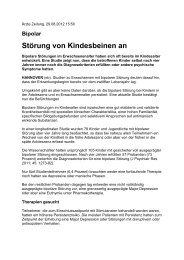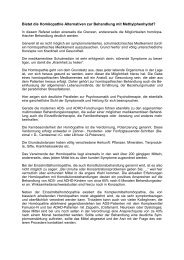Depressionen im Kindes- und Jugendalter
Depressionen im Kindes- und Jugendalter
Depressionen im Kindes- und Jugendalter
Sie wollen auch ein ePaper? Erhöhen Sie die Reichweite Ihrer Titel.
YUMPU macht aus Druck-PDFs automatisch weboptimierte ePaper, die Google liebt.
Leitthema<br />
<strong>Kindes</strong>- <strong>und</strong> <strong>Jugendalter</strong> systematische<br />
Untersuchungen. Daher sollte hiervon<br />
auch nur in Ausnahmefällen Gebrauch<br />
gemacht werden.<br />
In der bislang größten prospektiven<br />
Längsschnittstudie, der Great Smoky<br />
Mountain Study [4], zeigte sich insbesondere<br />
bei depressiven Mädchen eine erhöhte<br />
längerfristige Vulnerabilität für weitere<br />
psychiatrische Erkrankungen. Hier sollte<br />
für die Praxis in besonderem Maß darauf<br />
geachtet werden, dass Eltern, deren Kinder<br />
erstmalig an einer depressiven Episode<br />
gelitten haben, frühzeitig einen Arzt<br />
aufsuchen, wenn sich erneut Verhaltensauffälligkeiten<br />
jeglicher Art einstellen.<br />
Fazit für die Praxis<br />
F Auch <strong>im</strong> <strong>Kindes</strong>- <strong>und</strong> <strong>Jugendalter</strong><br />
sind <strong>Depressionen</strong> (depressive Episoden<br />
<strong>und</strong> Dysthymien) nicht selten.<br />
F Das Störungskonzept der Erwachsenenpsychiatrie<br />
lässt sich mit Modifikationen,<br />
die für eine valide Einschätzung<br />
des Störungsbildes hochrelevant<br />
sind, auch auf das <strong>Kindes</strong>- <strong>und</strong><br />
<strong>Jugendalter</strong> anwenden.<br />
F Bei der Diagnostik muss berücksichtigt<br />
werden, dass beide Kernsymptome<br />
der Depression bei Kindern <strong>und</strong><br />
Jugendlichen auf den ersten Blick<br />
nahezu ins Gegenteil verkehrt erscheinen<br />
können.<br />
F CDRS <strong>und</strong> MADRS sind bei Verdacht<br />
auf Depression <strong>und</strong> Dysthymia hilfreiche<br />
diagnostische Instrumente.<br />
Die Diagnosestellung erfolgt jedoch<br />
auf der Gr<strong>und</strong>lage des klinischen<br />
Urteils.<br />
F Die differenzialdiagnostische Abgrenzung<br />
der affektiven Erkrankungen<br />
von den Störungen des Sozialverhaltens<br />
ist auch therapeutisch<br />
wichtig.<br />
F Die therapeutischen Maßnahmen zur<br />
Behandlung von depressiven Erkrankungen<br />
bei Kindern <strong>und</strong> Jugendlichen<br />
umfassen psychoedukative, milieutherapeutische,psychotherapeutische<br />
sowie pharmakologische Interventionen,<br />
wobei die Psychotherapie<br />
am besten untersucht ist.<br />
46 | Monatsschrift Kinderheilk<strong>und</strong>e 1 · 2012<br />
Korrespondenzadresse<br />
Prof. Dr. M. Huss<br />
Klinik <strong>und</strong> Poliklinik für<br />
Kinder- <strong>und</strong> Jugendpsychiatrie<br />
<strong>und</strong> -psychotherapie,<br />
Universitätsmedizin Mainz<br />
Langenbeckstraße 1,<br />
55131 Mainz<br />
michael.huss@<br />
un<strong>im</strong>edizin-mainz.de<br />
Interessenkonflikt. Der korrespondierende Autor<br />
weist auf folgende Beziehungen hin:<br />
Beratungstätigkeit für die Firmen Shire <strong>und</strong> L<strong>und</strong>beck<br />
<strong>im</strong> Indikationsgebiet Depression, kein direkter Problembezug<br />
zum Artikel.<br />
Literatur<br />
1. Beardslee WR, Gladstone TR, O’Connor EE (2011)<br />
Transmission and prevention of mood disorders<br />
among children of affectively ill parents: a review. J<br />
Am Acad Child Adolesc Psychiatry 50(11):1098–1109<br />
2. Bettge S, Wille N, Barkmann C et al (2008) Depressive<br />
symptoms of children and adolescents in a German<br />
representative sample: results of the BELLA study. Eur<br />
Child Adolesc Psychiatry [Suppl 1] 17:71–81<br />
3. Birmaher B, Brent D, AACAP Work Group on Quality<br />
Issues (2007) Practice parameter for the assessment<br />
and treatmentof children and adolescents with depressive<br />
disorders. J Am Acad Child Adolesc Psychiatry<br />
46:11 (http://www.aacap.org/galleries/Practice-<br />
Parameters/Vol%2046%20Nov%202007.pdf)<br />
4. Costello EJ, Mustillo S, Erkanli A et al (2003) Prevalence<br />
and development of psychiatric disorders in<br />
childhood and adolescence. Arch Gen Psychiatry<br />
60(8):837–844<br />
Plenarsitzungen zu<br />
den Haupttumorarten<br />
Mittwoch, 22.2.2012<br />
Palliativmedizin<br />
Hauttumoren<br />
Donnerstag, 23.2.2012<br />
Prostatakarzinom<br />
Kolorektales Karzinom<br />
Freitag, 24.2.2012<br />
Lungentumoren<br />
Leukämien & Lymphome<br />
Samstag, 25.2.2012<br />
Mammakarzinom<br />
5. Epkins CC, Heckler DR (2011) Integrating etiological<br />
models of social anxiety and depression in youth:<br />
evidence for a cumulative interpersonal risk model.<br />
Clin Child Fam Psychol Rev 14(4):329–376<br />
6. Joseph MR, Philip LH (2009) Depression in children<br />
and adolescents. In: Joseph MR, Boris B (Hrsg) Treating<br />
child and adolescent depression. Wolters Kluwer,<br />
Köln, S 3–16<br />
7. Kirsch I, Deacon BJ, Huedo-Medina TB et al (2008) Initial<br />
severity and antidepressant benefits: a metaanalysis<br />
of data submitted to the Food and Drug Administration.<br />
PLoS Med 5(2):e45<br />
8. Klein DN, Shankman SA, Rose S (2008) Dysthymic disorder<br />
and double depression: prediction of 10-year<br />
course trajectories and outcomes. J Psychiatr Res<br />
42(5):408–415<br />
9. Meyer RE, Salzman C, Youngstrom EA (2010) Suicidality<br />
and risk of suicide – definition, drug safety concerns,<br />
and a necessary target for drug development:<br />
a consensus statement. J Clin Psychiatry 71(8):e1–<br />
e21<br />
10. Olfson M, Shaffer D, Marcus SC et al (2003) Relationship<br />
between antidepressant medication treatment<br />
and suicide in adolescents. Arch Gen Psychiatry<br />
60(10):978–982<br />
11. Parellada M, Moreno C, Moreno M (2011) Placebo effect<br />
in child and adolescent psychiatric trials. Eur Neuropsychopharmacol<br />
Oct 24. [Epub ahead of print]<br />
12. Posner K, Oquendo MA, Gould M (2007) Columbia<br />
classification algorithm of suicide assessment (C-CA-<br />
SA): classification of suicidal events in the FDA’s pediatric<br />
suicidal risk analysis of antidepressants. Am J<br />
Psychiatry 164(7):1035–1043<br />
13. Sondergard L, Kvist K, Andersen PK et al (2006) Do<br />
antidepressants precipitate youth suicide? A nationwide<br />
pharmacoepidemiological study. Eur Child<br />
Adolesc Psychiatry 15(4):232–240<br />
14. Wagner KD (2005) Pharmacotherapy for major depression<br />
in children and adolescents. Prog Neuropsychopharmacol<br />
Biol Psychiatry 29:819–826<br />
Berlin, 22.–25. Februar 2012<br />
(Messe <strong>und</strong> ICC Berlin)<br />
30. Deutscher Krebskongress<br />
Qualität sichern –<br />
Forschung fo(e)rdern<br />
Kongresspräsident<br />
Prof. Dr. Peter Albers<br />
Auskunft<br />
Kongress- <strong>und</strong><br />
Kulturmanagement GmbH<br />
Postfach 3664<br />
99407 We<strong>im</strong>ar<br />
Fon: + 49 (03643) 2468-0<br />
Fax: + 49 (03643) 2468-31<br />
dkk2012@kukm.de<br />
www.dkk2012.de










